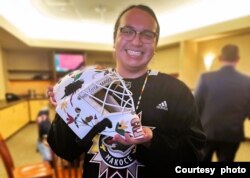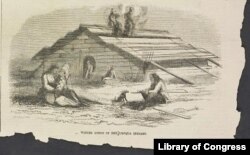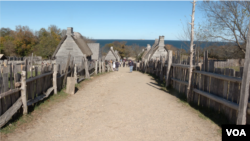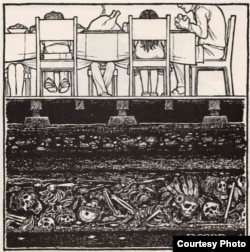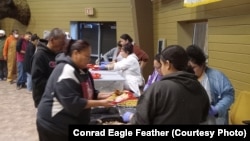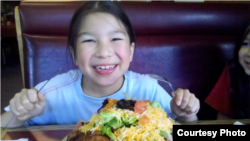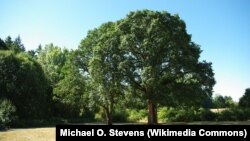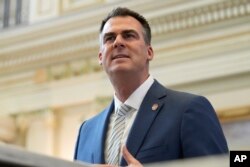Native Americans
Native American News Roundup Nov. 26 - Dec. 2, 2023
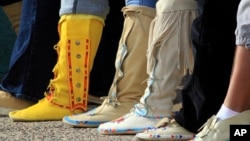
Calculating the wage gap for Native American and Native Hawaiian women
The last day of Native American Heritage Month in the United States was also Native Women’s Equal Pay Day, set aside to highlight that Native American and Alaska Native (NA/AN) women working full time, year-round, earn only about 55 cents for every dollar paid to non-Hispanic white men. Those who work part-time or part-year earn an average of 59 cents on the dollar.
These numbers vary by region. The National Partnership for Women and Families (NPWF) reports that on average, a Yup’ik woman in Alaska earns only 42 cents on the dollar. Considering that nearly two-thirds of Indigenous women are the sole breadwinners in their households and that more than four out of five Indigenous women experience violence, stalking or sexual assault in their lifetimes, these numbers are particularly alarming.
NPWF calculates that if these wage gaps were to close for a single year, the average Native woman could save enough money to buy another 32 months of food for her family, pay 19 more months in rent, and pay nearly three years of public university tuition and fees.
Read more:
Controversial hockey helmet fetches high bid at auction
On the National Hockey League’s Native American Heritage Day last Friday, Minnesota Wild hockey goalie Marc-Andre Fleury took to the ice in warmups wearing a mask he commissioned to honor his wife, who is said to be of Indigenous Canadian heritage.
He wore the mask despite threats of an NHL fine. Last summer, the NHL banned so-called “pride jerseys” that visibly recognize LGBTQ+ communities.
Fleury’s mask was designed by Mdewakanton Dakota artist Cole Redhorse Taylor, a member of the Prairie Island Indian Community or PIIC in Minnesota and a descendant of Chief Little Crow.
The helmet includes images of plants and flowers indigenous to Minnesota, the names of Fleury’s children, a quote from his father and the Dakota phrase Mni Sota Makoce, “land where the waters reflect the clouds,” from which the state took its name.
The team put the mask up for auction in support of the Minnesota Wild Foundation and the American Indian Family Center in the city of St. Paul. It sold for a whopping $75,100.
Read more:
Call-in show highlights traditional Indigenous winter homebuilding
This week’s Native America Calling featured a discussion about traditional Indigenous winter housing, built from local resources including wood, snow, mud and straw.
The daily live call-in program available on U.S. and Canadian public radio stations and online included Jesse Jackson, an educator from the Cow Creek Band of Umpqua Indians in Oregon, explaining to host Shawn Spruce (Laguna Pueblo) that because of its proximity to the Pacific Ocean, Oregon winters were wet, and people needed homes which would not only keep them warm but also dry. The answer was to use rot-resistant cedar planks on sites with good drainage.
Solomon Awa (Inupiat) is the Mayor of Iqaluit, the only city in the Canadian territory of Nunavut. He described the challenges of building igloos, domed houses built from blocks of packed snow.
While few Arctic peoples live in igloos anymore, some still construct them while out on hunting trips or when snowmobiles break down and leave them stranded.
“You don't have a blueprint, but make it for the size of your people,” Awa said. “There was the big one that we did not long ago…[it] was about 50 feet diameter probably, almost two-story high.”
To hear more guests talk about their winter building traditions, listen to the full broadcast here: https://www.nativeamericacalling.com/tuesday-november-28-2023-igloos-and-traditional-winter-homes/
The video (below), produced in 2012 by the Pitquhirnikkut Ilihautiniq/Kitikmeot Heritage Society in Nunavut, Canada, shows a group of Inuinnait from the Central Canadian Arctic building an igloo.
- By Dora Mekouar
Busting Myths About the First Thanksgiving

All About America explores American culture, politics, trends, history, ideals and places of interest.
Every year, on the fourth Thursday in November, Americans celebrate Thanksgiving. It's a commemoration of the 1621 harvest feast when the colonists, who came from England, shared a friendly meal with the land's Indigenous people.
In Plymouth, Massachusetts, site of the first Thanksgiving, historians and others try to separate fact from fiction surrounding the legend that grew out of that initial celebratory feast that took place more than 400 years ago.
"The problem with it is that there are so many stereotypes and so much misinformation that's bundled into that story," says Paula Peters, a citizen of the Mashpee Wampanoag Tribe whose ancestors are believed to have been at the first Thanksgiving. "It's a story that really marginalizes the Wampanoag history."
The pilgrims arrived on the Mayflower in 1620. By their second winter, they were struggling, until the Indigenous people taught them how to plant crops and live off the land.
"When we think about the pilgrims coming over, we forget about the aspect of the Wampanoag people helping them survive that winter, or even navigate this land, or navigate the waters, which is very important," says Wampanoag Tribe member Malissa Costa, who oversees the Native American-themed exhibit at the Plimoth Patuxet Museums.
The living history museum, located a few kilometers from the site of the first Thanksgiving, also features a 17th-century English village. Actors dress up as pilgrims to depict the colonists' way of life, while Thanksgiving traditions are recreated for visitors.
"What the pilgrims are celebrating is literally that they are going to have food. They are not going to starve in the coming year," says Malka Benjamin, director for colonial interpretation and training at the Plimoth Patuxet Museums. "And so, guests are going to be able to help with cooking preparations for the celebration. They might get pulled into a game, a sport ... there's going to be musket firing demonstrations."
It was the sounds of guns going off that prompted Native Americans to investigate, which is how her Wampanoag ancestors came to be at the first Thanksgiving, according to Peters.
"At some point, they decided, 'Oh, this isn't a threat. They're just celebrating their harvest.' And guess what? We're all here now, so, we're all going to eat," says Peters, who used to work at the Plimouth Patuxet Museums.
That part of the story is disputed by Peters' former colleague, Richard Pickering, chief historian at the living history museum, who says that theory was discussed, but then discarded, by the museum.
The conflicting viewpoints underscore the reality that no one really knows exactly what happened at the first Thanksgiving. There are almost no firsthand accounts of the event, but there are references to a "special celebration" of the successful harvest, which included Wampanoag leader Massasoit and about 90 of his people, which included women, according to Pickering.
"For three days, we entertained and feasted," pilgrim Edward Winslow wrote in a letter to a friend in 1621. Winslow attended the harvest celebration.
"Ultimately, what happens in Plymouth in the fall of 1621 is the highest level of diplomacy," says Pickering, adding that the shared meal was a product of the alliance between the newcomers and the Native people.
"It is their willingness to show them their ways that saves the English that second year. So, we should not be projecting any kind of distrust, animus, on that event. But we should recognize that their children and their grandchildren could not sustain it," he said.
About 90% of the Native population was eventually wiped out by diseases that came with the Europeans. And the respect the pilgrims initially showed the Native people eventually gave way to disdain and dehumanization.
"As the English population grows from those 52 English men, women and children that survived the first winter to the 25,000 or more that are here 20 years later, Native people are seen as being in the way of the commodities that the English want," Pickering says. "They want their land. They want them off that land. And so, you see a changing attitude from one of admiration to one of stereotyping and derision. And it's that kind of thought that enables them to want to push them off the land with no sense of guilt."
The pilgrims originally came to America in search of religious freedom but apparently not for all, says Peters.
"They sacrificed so much for religious freedom, but they didn't offer that same grace to the Indigenous people who lived here to begin with," she says.
Harvest meal
Today, Americans often eat traditional Thanksgiving foods that include turkey, stuffing, sweet and mashed potatoes and pumpkin pie. As to what was at the original three-day feast, the museum has a display of the foods that were probably eaten at the 1621 meal.
"You have roast turkey, roast goose, and you'll see all of the classic corn, beans and squash. There's maize, beans and squash," says Pickering, pointing out the foods in a display case. "And also, the standing dish of New England, stewed pumpkin, mussels, to represent all the shellfish that was eaten."
It's believed the Wampanoag brought deer they'd hunted.
"And there probably would be some cranberries, because that was the fruit of the season," Peters says.
Into the future
The Mashpee Wampanoag Tribe has begun initial proceedings to establish their own living history museum.
The town of Mashpee, located about 43 kilometers from Plymouth, is negotiating the potential transfer of three parcels of land to the tribe for a traditional Wampanoag village and living history museum.
Costa, who oversees the similar effort at the Plimoth Patuxet Museums, is keen for visitors to know that Native Americans shouldn't be relegated to the past.
"The main thing I want them to learn is that Wampanoag people are still here," Costa says. "I want them to think of Wampanoag people as not just in the past — or even Indigenous people as in the past — but as in the present still making their way, still teaching the public."
Native Americans Regard Thanksgiving With Mixed Emotions
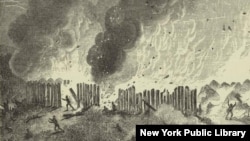
Each year on the last Thursday of November, families in the United States gather to celebrate Thanksgiving. It was originally intended as a day of prayer and gratitude — not just for good harvests but for a leader's good health or success in battle.
Today, the holiday revolves around a sentimentalized retelling of the 1620 landing of Puritan refugees at Plymouth, Massachusetts, and the harvest feast they shared with local Wampanoags.
That version omits the fact that 17 years later, Puritans would set fire to a fortified Pequot village, burning men, women and children alive.
Today, Native Americans regard Thanksgiving with mixed emotions.
"Native Americans eat and watch football just like other Americans," said Shawna Shale, a Quinault woman living in Fergus Falls, Minnesota. "But for some, it is a reminder of a dark past that is hard to celebrate."
She admits that she often wonders how differently life would have turned out if the Wampanoag tribe decided not to ally itself with the Plymouth pilgrims.
Thanksgiving memories
Many Native Americans never heard of Thanksgiving until they were sent to boarding school.
"[I am] a second-generation turkey eater, after my parents," said artist Roberta Begay, a Diné (Navajo) citizen living in Albuquerque, New Mexico. "It's a boarding school tradition. I never understood it as anything other than a time for a family gathering, eating and helping my grandparents by hauling water or going out for firewood."
Phoenix, Arizona, resident Reva Stewart, also Diné, experienced her first Thanksgiving in a Christian boarding school. She was 4 years old.
"We were given Thanksgiving dinner with the idea that we should be grateful that we were saved," she said. "Today, my family celebrates being together as a family, and we teach our children the traditional ways and not the colonizers' [version] of what happened in the past."
A sad anniversary
Amanda Takes War Bonnet is an Oglala Lakota journalist working as a public education specialist with a South Dakota nonprofit group devoted to ending violence against Indigenous women.
"My mother would always have a nice meal on Thanksgiving, with pies and everything homemade," she recalls. "It also meant hunting season had started, so the meal was held after the guys [came back from] hunting."
Thanksgiving now holds little meaning for her.
"Some years back, my son brought this huge turkey from his work to share with family. I didn't estimate the cooking time right, so we had to start the meal without it," she said.
"My son died in front of us from a heart attack," she said. "That big bird dried up in the oven, forgotten."
She never roasted another turkey after that.
"Maybe someday, we will heal, but for now, 'Turkey Day' is just a great holiday to not work and relax with a prime rib roast."
'A golden opportunity'
Oglala Lakota journalist James Giago Davies grew up in Rapid City, South Dakota, where churches and charity groups gave out free turkeys and all the "fixings."
"We were a poor Native family, struggling to survive," he said. "Thanksgiving was a golden opportunity to get extra food and have a good meal. We never thought of it beyond that immediate pressing reality, and I don't know of any families from my 'rez' who did. Maybe it is different now."
David Cornsilk, a citizen of the Cherokee Nation from Tahlequah, Oklahoma, grew up in a traditional household where Thanksgiving was never celebrated.
"My dad opposed it, saying there was nothing Indian people had to celebrate in America," Cornsilk said. "But he never talked about history. It was not until high school that I learned the truth about Indigenous history and then only because I had become a voracious reader of history."
Years later, Cornsilk married into a Cherokee family he describes as the "polar opposite."
"Where we were traditional, they were Christian. Where we rejected Thanksgiving, they embraced it and had a huge feast with a large family gathering," he said.
It is a tradition he has passed on to his children and grandchildren.
"The difference will be that my children and grandchildren know their history," he said. "We give thanks for our blessings and share our bounty in a land we love with the people we love."
'Takesgiving'
Lynn Eagle Feather, a Sicangu Lakota living in Denver, Colorado, says she lost her son to police violence in July 2015 and has been seeking justice ever since.
"Thanksgiving?" she asks. "You mean 'Takesgiving.'"
She plans to spend the holiday demonstrating outside of a Denver hospital where staff cut off the waist-length hair of 65-year-old Oglala Lakota elder Arthur Janis, without his or his family's permission, while he was undergoing medical treatment.
"This is Native American Heritage Month," Eagle Feather said, "and our people are still suffering."
Solar Panels Over Canals in Gila River Indian Community Will Help Save Water
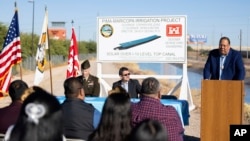
In a move that may soon be replicated elsewhere, the Gila River Indian Community recently signed an agreement with the U.S. Army Corps of Engineers to put solar panels over a stretch of irrigation canal on its land south of Phoenix.
It will be the first project of its kind in the United States to break ground, according to the tribe’s press release.
“This was a historic moment here for the community but also for the region and across Indian Country,” said Gila River Indian Community Governor Stephen Roe Lewis in a video published on X, formerly known as Twitter.
The first phase, set to be completed in 2025, will cover 1,000 feet of canal and generate one megawatt of electricity that the tribe will use to irrigate crops, including feed for livestock, cotton and grains.
The idea is simple: install solar panels over canals in sunny, water-scarce regions where they reduce evaporation and make renewable electricity.
“We’re proud to be leaders in water conservation, and this project is going to do just that,” Lewis said, noting the significance of a Native, sovereign, tribal nation leading on the technology.
A study by the University of California, Merced estimated that 63 billion gallons of water could be saved annually by covering California’s 4,000 miles of canals. More than 100 climate advocacy groups are advocating for just that.
Researchers believe that much of the installed solar canopies would additionally generate a significant amount of electricity.
UC Merced wants to hone its initial estimate and should soon have the chance. Not far away in California's Central Valley, the Turlock Irrigation District and partner Solar AquaGrid plan to construct 1.6 miles (2.6 kilometers) of solar canopies over its canals beginning this spring and researchers will study the benefits.
Neither the Gila River Indian Community nor the Turlock Irrigation District are the first to implement this technology globally. Indian engineering firm Sun Edison inaugurated the first solar-covered canal in 2012 on one of the largest irrigation projects in the world in Gujarat state. Despite ambitious plans to cover 11,800 miles (19,000 kilometers) of canals, only a handful of small projects ever went up, and the engineering firm filed for bankruptcy.
High capital costs, clunky design and maintenance challenges were obstacles for widespread adoption, experts say.
But severe, prolonged drought in the western U.S. has centered water as a key political issue, heightening interest in technologies like cloud seeding and solar-covered canals as water managers grasp at any solution that might buoy reserves, even ones that haven't been widely tested, or tested at all.
Still, the project is an important indicator of the tribe's commitment to water conservation, said Heather Tanana, a visiting law professor at the University of California, Irvine and citizen of the Navajo Nation. Tribes hold the most senior water rights on the Colorado River, though many are still settling those rights in court.
“There's so much fear about the tribes asserting their rights and if they do so, it'll pull from someone else's rights,” she said. The tribe leaving water in Lake Mead and putting federal dollars toward projects like solar canopies is “a great example to show that fear is unwarranted.”
The federal government has made record funding available for water-saving projects, including a $233 million pact with the Gila River Indian Community to conserve about two feet of water in Lake Mead, the massive and severely depleted reservoir on the Colorado River. Phase one of the solar canal project will cost $6.7 million and the Bureau of Reclamation provided $517,000 for the design.
Native American News Roundup November 12-18, 2023

These are some of the Native American-related stories that made headlines this week:
Oklahoma lawmaker, union boss, come close to blows in Senate hearing room
Oklahoma Republican Senator Markwayne Mullin, a former mixed martial arts fighter and a citizen of the Cherokee Nation, says he isn’t sorry for challenging Teamster president Sean O’Brien to a fist fight during a Senate committee hearing on Tuesday.
Independent Senator Bernie Sanders, chairman of the Senate Health, Education, Labor and Pensions Committee, was forced to intervene.
This wasn’t the pair’s first clash. During a committee hearing in March, O’Brien and Mullin shouted at each other. That led to a series of angry exchanges on social media platform X. In June, O’Brien challenged Mullin to a fight.
“You know where to find me. Anyplace, anytime, cowboy,” O’Brien said.
Mullin responded on X:
That fight never took place.
“People ask me today is this becoming of a U.S. senator,” Mullin told FOX News. “In Oklahoma, you don’t run your mouth like that, and if you do run your mouth like that, you’re expected to be called out on it.”
Read more:
Feds to fund Native Hawaiian-led climate resilience program
Democratic Senator Brian Schatz, chairman of the Senate Committee on Indian Affairs, this week announced $20 million in funding for the Kapapahuliau Climate Resilience Program to help the Native Hawaiian community mitigate the challenges of climate change.
“Through the Kapapahuliau Climate Resilience Program, the federal government is directly funding Native Hawaiian-led climate solutions for the first time ever,” Schatz said. “This $20 million down payment — part of the Inflation Reduction Act’s historic investment in climate action — recognizes the critical role of the Native Hawaiian Community in charting a path towards a sustainable, climate resilient future in Hawaii and beyond.”
The Fifth U.S. National Climate Assessment, released earlier this week, says Indigenous peoples and their knowledge will be central to the resilience of Hawaiian and Pacific Island communities addressing changing climate.
Read more:
USDA to fund traditional Native American forestry in Oregon
The U.S. Department of Agriculture’s Natural Resources Conservation Service has awarded $9.23 million to the Oregon Agricultural Trust (OAT) and its partners for projects using traditional Native American land management practices to restore Oregon’s oak habitat.
Long before Europeans set foot in North America, Indigenous communities used fire to clear land for agriculture or roadways, rejuvenate plants, eradicate pests and avoid devastating wildfires.
Since 2000, wildfires have become larger and more frequent across the United States, and a growing number of localities have begun to embrace so-called “cultural burns” as part of the solution.
“Use of cultural fire, traditional fire, on the landscape usually entails people who are trained or have the wildfire qualifications,” said Ka-Voka Jackson, program manager for the EcoStudies Institute, an OAT partner. “That usually entails fire trucks or water resources, the use of drip torches, other hand tools.”
The project will work with tribes to protect Oregon’s iconic oak trees. It will also give Native Americans access to oak forests for cultural use and environmental stewardship.
Read more:
Confusion in Oklahoma over state, tribal vehicle law
Tribal leaders in Oklahoma are outraged after a state police officer stopped an Otoe-Missouria tribal citizen for speeding and gave her two tickets: one for speeding and a another for failing to pay state motor vehicle taxes because she did not live on tribal land.
The U.S. Supreme Court ruled in 1993 that Indigenous Oklahomans could register a vehicle through their tribe if they reside inside reservation boundaries. The ruling also says the state doesn't have the authority to tax tribal citizens living on reservations.
Three of the 39 tribes in Oklahoma — the Cherokee, Chickasaw and Choctaw — have compacts with the state that allow tribe members to drive with tribal car tags wherever they live.
Members of the other 36 tribes that do not have compacts — including the Otoe-Missouria — are supposed to register their vehicles with the state.
Oklahoma Governor Kevin Stitt, says his main concern is that some tribal governments don't share vehicle registration information with the Department of Public Safety, making it a “public safety issue that puts law enforcement and others at risk.”
Otoe-Missouria Chairman John Shotton suggests the state has not enforced the law until now.
“After over 20 years of cooperation between the State and Tribes regarding vehicle tag registration, it appears the State has altered its position of understanding concerning tribal tags,” Shotton said in a statement. “This change was made without notice or consultation with all Tribes that operate vehicle tag registration.”
Read more:





